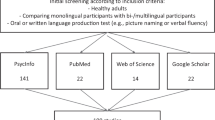Abstract
The present study aimed at evidencing some of the factors linked to word identification speed in bilinguals. The performances of beginning and of skilled bilinguals on tasks related to single-word decoding were assessed in both the first and the second language. Results of a first experiment showed that whereas both groups of bilinguals demonstrated use of orthographic redundancies specific to their native language, only the skilled group did so as concerns second-language redundancies. It was seen in a second experiment, however, that the use or nonuse of orthographic structure cannot in itself account for the pattern of lexical decision latencies observed for words in the two languages. Rather, this pattern is consistent with the idea that word recognition latency is largely dependent upon subjects' past experience with and actual use of words.
Similar content being viewed by others
References
Aderman, D., & Smith, E. E. (1971). Expectancy as a determinant of functional units in perceptual recognition.Cognitive Psychology, 2, 117–129.
Baron, J., & Thurston, I. (1973). An analysis of the word superiority effect.Cognitive Psychology, 4, 207–228.
Brown, T. L., Carr, T. H., & Chaderjian, M. (1987). Orthography, familiarity, and meaningfulness reconsidered: Attentional strategies may affect the lexical sensitivity of visual code information.Journal of Experimental Psychology: Human Perception and Performance, 13, 127–139.
Carterrette, E. C., & Jones, M. H. (1974).Informal speech: Alphabetic and phonemic texts with statistical analyses and tables. Berkeley: University of California Press.
Costermans, J., & Galland, J. (1980). Sur l'accessibilite du lexique chez les bilingues.Canadian Journal of Psychology, 34, 381–387.
Favreau, M., Komoda, M. K., & Segalowitz, N. (1980). Second language reading: Implications of the word superiority effect in skilled bilinguals.Canadian Journal of Psychology, 4, 370–381.
Favreau, M., & Segalowitz, N. (1983). Automatic and controlled processes in the first-and second-language reading of fluent bilinguals.Memory & Cognition, 11, 565–574.
Fraisse, P., Noizet, G., & Flament, C. (1963). Fréquence et familiarité du vocabulaire. In J. de Ajuriaguerra, F. Bresson, P. Fraisse, B. Inhelder, P. Oleron & J. Piaget (Eds.),Problèmes de psycholinguistique. Paris: Presses Universitaires de France.
Gardner, M. K., Rothkopf, E. Z., Lapan, R., & Lafferty, T. (1987). The word frequency effect in lexical decision: Finding a frequency-based component.Memory & Cognition, 15, 24–28.
Gernsbacher, M. A. (1984). Resolving 20 years of inconsistent interactions between lexical familiarity and orthography, concreteness and polysemy.Journal of Experimental Psychology: General, 113, 256–281.
Gordon, B. (1985). Subjective frequency and the lexical decision latency function: Implications for mechanisms of lexical access.Journal of Memory and Language, 24, 631–645.
Magiste, E. (1979). The competing language systems of the multilingual: A developmental study of decoding and encoding processes.Journal of Verbal Learning and Verbal Behavior, 18, 79–89.
Mark, L. S., Shankweiler, D., Liberman, I. Y., & Fowler, C. A. (1977). Phonetic recoding in beginning readers.Memory & Cognition, 5, 623–629.
Mason, M. (1978). From print to sound in mature readers as a function of reader ability and two forms of orthographic regularity.Memory & Cognition, 6, 568–581.
Massaro, D. W. (1979). Letter information and orthographic context in word perception.Journal of Experimental Psychology: Human Perception and Performance, 5, 596–609.
Massaro, D. W., & Taylor, G. A. (1980). Reading ability and utilization of orthographic structure in reading.Journal of Educational Psychology, 72, 730–742.
O'Regan, J. K., Lévy-Schoen, A., Pynte, J. & Brugaillere, B. (1984). Convenient fixation location within isolated words of different length and structure.Journal of Experimental Psychology: Human Perception and Performance, 10, 250–257.
Perfetti, C. A., Finger, E., & Hogaboam, T. W. (1978). Sources of vocalisation latency differences between skilled and less skilled readers.Journal of Educational Psychology, 70, 730–739.
Ransdell, S. E., & Fischler, I. (1987). Memory in a monolingual mode: When are bilinguals at a disadvantage?Journal of Memory and Language, 26, 392–405.
Soares, C. & Grosjean, F. (1984). Bilinguals in a monolingual and bilingual speech mode: The effect on lexical access.Memory & Cognition, 12, 380–386.
Thorndike, E. L., & Lorge, L. (1944).The teacher's word book of 30,000 words. New York: Bureau of Publications, Teacher's College, Columbia University.
Author information
Authors and Affiliations
Rights and permissions
About this article
Cite this article
Frenck-Mestre, C. Use of orthographic redundancies and word identification speed in bilinguals. J Psycholinguist Res 22, 397–409 (1993). https://doi.org/10.1007/BF01074343
Issue Date:
DOI: https://doi.org/10.1007/BF01074343




